Close But No Cigar
The Influence of a Near-Miss Wildfire on Resident Risk Perceptions and Mitigation Behaviors
Publication Date: 2019
Abstract
This research used protection motivation theory to examine if and how individuals who experience a near-miss wildfire event (i.e., a recent, proximal wildfire that did not harm individuals or their properties) intend to protect themselves against future risks. We administered a drop-off pick-up survey to residents living in Durango, Colorado, a community heavily impacted by the 416 Fire in the spring and summer of 2018. The survey, completed by 195 residents, solicited information about wildfire mitigation behaviors taken before and after the 416 Fire. Data were also collected on the four dimensions of protection motivation theory which might influence individual willingness to mitigate future wildfire risks. Response efficacy was a significant predictor of four pre-fire mitigation actions. Self-efficacy was also a significant predictor of two post-fire mitigation actions. Furthermore, significant differences exist for all pre- and post-fire mitigation actions, which show the impact that the fire had on respondent intentions to mitigate for future wildfire risks. This research contributes to the broader literature by identifying how perceptions and mitigation behaviors change after experiencing a near-miss wildfire event. It also provides insights for local wildfire management on specific mitigation actions that could be incentivized with local assistance programs.
Introduction
Wildfires are increasing in frequency and severity across the West. Additionally, a growing number of people are living in at-risk wildland urban interface areas (Radeloff et al., 20181). With greater proportions of the population being exposed to the risk of more probable wildfires, federal, state, and local land managers need to understand how homeowners prepare for, and respond to, wildfire risks. Despite the fact that social scientists have made substantial efforts to better understand homeowners’ risk perceptions and their preparedness behaviors in anticipation of future wildfires, little is known about how risk perceptions and mitigation behaviors change in response to experiencing a near-miss wildfire event (Dupéy & Smith, 20182; McCaffrey & Olsen, 2012 3; McCaffrey et al., 20134; Toman et al., 20135).
Previous research has found an increase in individual preparedness immediately following a natural hazard event (Russell et al., 19956). Surveying residents in the months following a wildfire can provide a deeper understanding of how experience with wildfire shapes individual risk perceptions associated with future wildfires, and their behavioral intentions to lower vulnerability to the risks associated with future fires.
Near-miss events describe avoided disasters which have the potential to result in extreme damage (e.g., loss of life or property). Near-miss events can provide a false sense of security to individuals. Research on near-miss events in the context of hurricanes has shown that individuals who experience near-miss events are likely to have perceptions that reflect this ‘missed’ experience; they are likely to believe and make subsequent decisions based on the idea that the situation is less risky (Dillon & Tinsley, 20167; Dillon et al., 20118). Near-miss wildfire events in the wildland-urban interface (WUI) have not been empirically examined despite the fact that these individuals are likely to perceive and make decisions based on this ‘missed’ experience.
This study uses protection motivation theory to better understand how WUI residents that have experienced a near-miss wildfire event perceive future risks and whether or not they intend to implement mitigation actions that will reduce this future risk. Protection motivation theory suggests two processes—threat and coping appraisals—shape an individual’s decision to protect themselves and their property from a given threat (Figure 1; Bubeck et al., 20129). Threat appraisals involve individuals identifying how bad the consequences of a threat will be (perceived severity) and estimating the probability of that threat occurring (perceived vulnerability). Next, coping appraisals involve individuals’ belief that a specific mitigation action will reduce future risks (response efficacy), their assessment of their capacity to carry out the action (self-efficacy), and their estimate of how much will it cost (in time, money labor, etc.) to implement the action (response costs) (Bubeck et al., 2012). Results from the combination of these two appraisals helps predict if an individual will engage in a protective or maladaptive (non-protective) response to a threat (Figure 1).
Figure 1. The appraisal processes and associated dimensions of protection motivation theory.

This study was guided by two general research questions:
- Which, if any, dimension of protection motivation theory was the best predictor of wildfire mitigation behaviors?
- Does a recent, proximal, wildfire influence residents’ perceptions of self-reported mitigation behaviors?
Background on the 416 Fire
Figure 2. The 416 Wildfire burn perimeter (red polygon) and all residences included in the study sample (green dots).
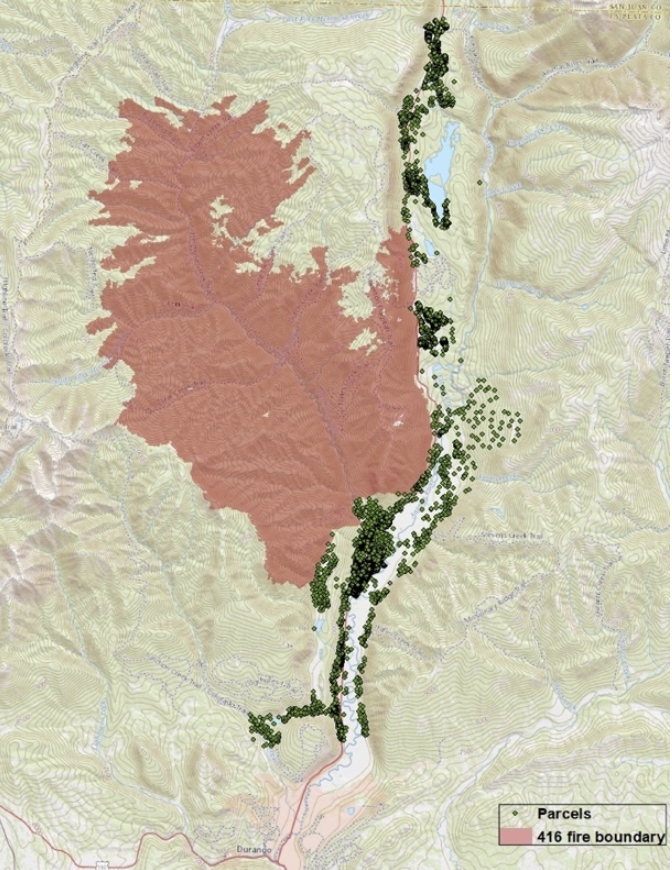
The 416 Fire (Figure 2) was identified by tracking active wildfires throughout the 2018 fire season using InciWeb data (InciWeb, n.d.)10. This database provides detailed information on active wildfires (e.g., location, start date, anticipated containment date, size, weather concerns, projected fire activity). The 416 Fire in La Plata County, Colorado was selected due to meeting our fire selection criteria (it exceeded 8,000 ha [~20,000 acres]) pre-containment, involved the evacuation of at least 100 residents, had wildland-urban interface and intermix areas within 6 kilometers (~10 miles), and had an anticipated containment date of 8/1/2018. The 416 Fire started on Friday June 1, 2018 around 10:02 a.m. approximately 6 kilometers (~10 miles) north of Durango, Colorado. The cause of the fire is still unknown, however there are strong accusations and lawsuits against the Durango & Silverton Narrow Gauge Railroad, perceived as the ignition source (Romeo, 201811). The 416 Fire blazed through approximately 21,613 ha (83 mi2) of U.S. Forest Service land and 292 ha (1.1 mi2) of private land consisting of brush (< 0.5 m; < 2.0 ft), timber (grass and understory), and timber (litter and understory) fuels.
The location of the 416 Fire and nearby residents provided a unique opportunity to understand how residents protected themselves before, and plan to protect themselves following a recent, proximal fire. The 416 Fire placed a direct threat on the residents in the Animas Valley along Highway 550, where the wildland urban interface and intermix is present. The fire perimeter encroached on interface and intermix residents on the west side of the valley. The valley is very narrow, with one main entrance to the north and one to the south. This can present difficulty in evacuating residents. Many residents in the Animas Valley evacuated from their homes, and a number of them were exposed to fire related risks (e.g., smoke, limited evacuation routes, immediate proximity to fire). The proximity of the 416 Fire and the location of residents allowed us to collect data on individuals who were more likely to respond to wildfire in a protective manner, compared to those who experienced a similar fire but were more than a 1.0 km from the perimeter, or were only impacted by smoke.
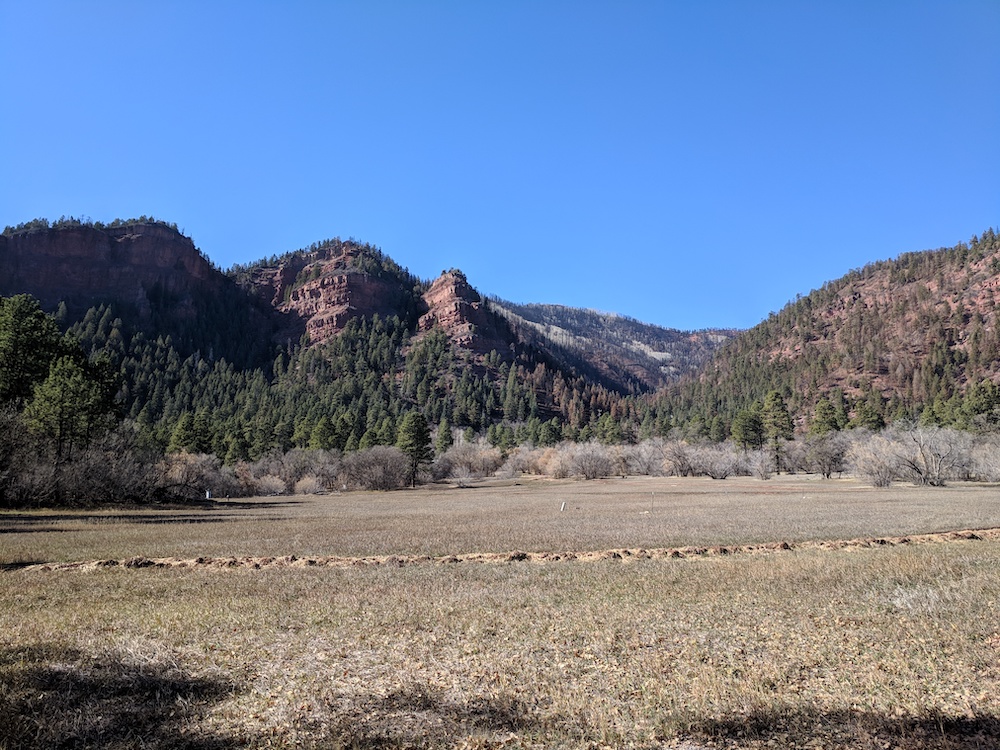
Methods
Survey procedures
Spatial data for the 416 Fire, evacuation zone, and parcel data from La Plata County were compiled to identify all residents near the eastern burn perimeter. We sampled both individuals that were and were not evacuated during the 416 Fire. Spatial boundaries were identified to only sample residents who were within the northern and southern ends of the 416 evacuation zone. We excluded parcels with two addresses (indicating the parcel was a second home), condominiums, apartments, and other rental properties, since these individuals are not likely to engage in wildfire mitigation on their property. All residents within these geographic and sampling boundaries were included as potential survey respondents. We used a random number generator to pull 500 parcels based on a geospatial ID number into a sampling list. The sampled parcels were mapped to maximize travel time between parcels during the drop-off/pick-up survey effort. Once in the field it was apparent that parcels in the northern valley were second and vacation homes with little to no current occupancy, thus, these parcels were excluded from sampling. To account for this loss, we randomly re-sampled the remaining southern parcels to reach the desired sample size (n = 500).
Previous research has shown substantially higher average response rates for drop-off/pick-up surveys when compared to traditional mail surveys (Lovelock et al., 197612; Melevin et al., 199913). To achieve the highest response rate possible, we used self-administered surveys with the option to mail the survey back in a pre-paid envelope. Surveys were delivered in person by three research team members, one of whom was the lead author on this report. We knocked on each door selected from the random sample and asked for the person in charge of yard and house maintenance (as an indicator for head of household). Asking the head of the household to complete the survey during an in-person exchange can increase response rates by approximately 10 to 37 percent compared to other methods (i.e., handing the survey to whomever answers the door, or leaving the survey on the doorknob with no face-to-face contact) (Melevin et al., 1999). When there was no answer, surveys were left on the doorknob. The surveys were delivered between November 7 and November 21, 2018.
Data collection
The drop-off/pick-up survey was designed to measure each of the processes described in the protection motivation theory literature. Protection motivation theory posits that two cognitive appraisals (threat and coping appraisals) shape the decision to protect one’s self from a given threat (Bubeck, Botzen & Aerts, 2012). Threat appraisals includes two dimensions: 1) perceived severity (how bad the consequences of a threat will be) and 2) perceived vulnerability (the probability of a threat occurring). Coping appraisals includes three dimensions: 1) response efficacy (belief that the mitigation action taken will reduce risk); 2) self-efficacy (belief in one’s capacity to carry out the action); and 3) the response costs (how much will it cost to implement the action) (Bubeck, Botzen & Aerts, 2012). Threat and coping appraisals are believed to substantially influence whether or not an individual will engage in a protective or maladaptive (non-protective) response to a threat. Due to the cross-sectional nature of our study, we were not able to ask about all five dimensions of protection motivation theory before and after the 416 Fire. Perceived severity before the 416 Fire was elicited by asking residents to estimate their level of concern about wildfire before the fire. For both perceived severity and response efficacy, we asked respondents to estimate their beliefs before the fire as well as at the time they were surveyed (i.e., post-fire). Self-efficacy and response costs were only measured at the time residents were surveyed. The specific questions intended to measure each dimension of protection motivation theory are shown in Table 1; these questions were created by the authors after reviewing the literature on cognitions related to wildland fire (Dupéy & Smith, 2017).
Table 1. Appraisal processes, dimensions, definitions, and drop-off/pick-up survey questions associated with protection motivation theory.

In addition to the measures of the five dimensions characterized by protection motivation theory, the survey included questions to provide context on: awareness of and participation in local mitigation programs, barriers to previous and intended wildfire mitigation, and evacuation experiences. The survey was designed to examine which dimensions of protection motivation theory influenced past or future mitigation behaviors. The drop-off/pick-up survey included: • All five dimensions of protection motivation theory related to wildfire events in the Animas Valley;
- Mitigation behaviors before and after the 416 Fire;
- Barriers to implementing mitigation behaviors before and after the 416 Fire;
- Experiences with the evacuation during the 416 Fire; and
- Respondents’ sociodemographic characteristics.
Data analysis
Descriptive analyses investigated standard sociodemographic information (e.g., gender, education, income), and non-traditional demographic information that may lead to insights on what these individuals are protecting (e.g., children, livestock, pets). This analysis also included evacuation experiences, awareness of and participation in local mitigation programs, and barriers to mitigation across all survey respondents.
To answer research question 1 (Which, if any, facet of protection motivation theory is the best predictor of wildfire mitigation behaviors?) we used a series of eighteen binary logistic regression models. The dependent variables in these models were the nine mitigation behaviors residents could have taken, or could take in the future, to reduce their wildfire risk. We asked about residents’ behaviors both before and after the 416 Fire, creating a total of 18 behavioral measures. We regressed each behavior on the appropriate set of items corresponding to each of the dimensions of protection motivation theory. To answer research question 2 (Does a recent, proximal, wildfire influence resident perceptions or self-reported mitigation behaviors?) we compared respondents’ perceived vulnerability and wildfire mitigation actions* pre- and *post-416 Fire and ran Chi-square tests to examine * pre- and *post-416 Fire mitigation behaviors.
Results
Descriptive analysis
In total, 500 surveys were delivered to residents within the pre-evacuation and evacuation zones. Of those, two residents (0.4 percent) declined to participate and therefore did not receive a survey, 204 (40.8 percent) were face-to-face deliveries and 294 (58.8 percent) were left on the doorknob. A total of 195 usable surveys were returned for a total response rate of 39 percent. We did not conduct any tests for non-response bias given the response rate was more than acceptable for public opinion research (Dillman et al., 200814).
To describe our respondents, we separated them into short- and long- term based on research that designates 10 or more years as ‘long-term’ (Hunter et al., 2005)15. We had nearly equal responses from short-term (49 percent) and long-term (51 percent) residents. Additionally, the overwhelming majority (94 percent) of respondents were primary residents (i.e., the parcel was not a vacation home or second home). We also had nearly equal responses from males (54 percent) and females (45 percent) (Table 2). More than 75 percent were born between 1930 and 1970 and nearly half were retired (48 percent). Those who were still employed held a number of jobs, such as carpenter, civil engineer, chef, mechanic, professor, restaurant owner, ski instructor, truck driver, and writer. Our respondents were well educated; nearly 80 percent had a bachelors, masters, doctoral, or professional degree. They were also fairly affluent; the average annual household income was $131,176 with less than 10 percent having an annual household income under $40,000.
Table 2. Demographics of 416 Wildfire survey respondents.

Evacuation experiences

We asked three questions to better understand the evacuation experiences of respondents. First, we identified the number of respondents who were on mandatory evacuation (39.8 percent) the number who were on pre-evacuation but still chose to evacuate (8.2 percent), and the number who did not evacuate (50 percent). We asked those who evacuated (by choice or mandate) to indicate any ‘last minute’ actions they took to protect their home or property. Approximately 71 percent indicated they implemented at least one protective measure before evacuation. The most common protective actions included moving flammable or combustible material from the deck or around the house (30.5 percent), leaving water buckets and/or hoses out for firefighters (25.7 percent), and turning off propane or moving gas tanks from the house (24.8 percent). Some residents (<10 percent) cleared brush from next to the house, left lights on, left notes or signs for firefighters, or shut their windows and vents. Finally, we asked respondents who were evacuated to indicate how far they had to travel to get to their temporary evacuation location. Distances ranged from 1.6 kilometers (1 mile) to 1600 kilometers (1000 miles), with an average distance of 74 miles.
Awareness of and participation in local wildfire mitigation programs
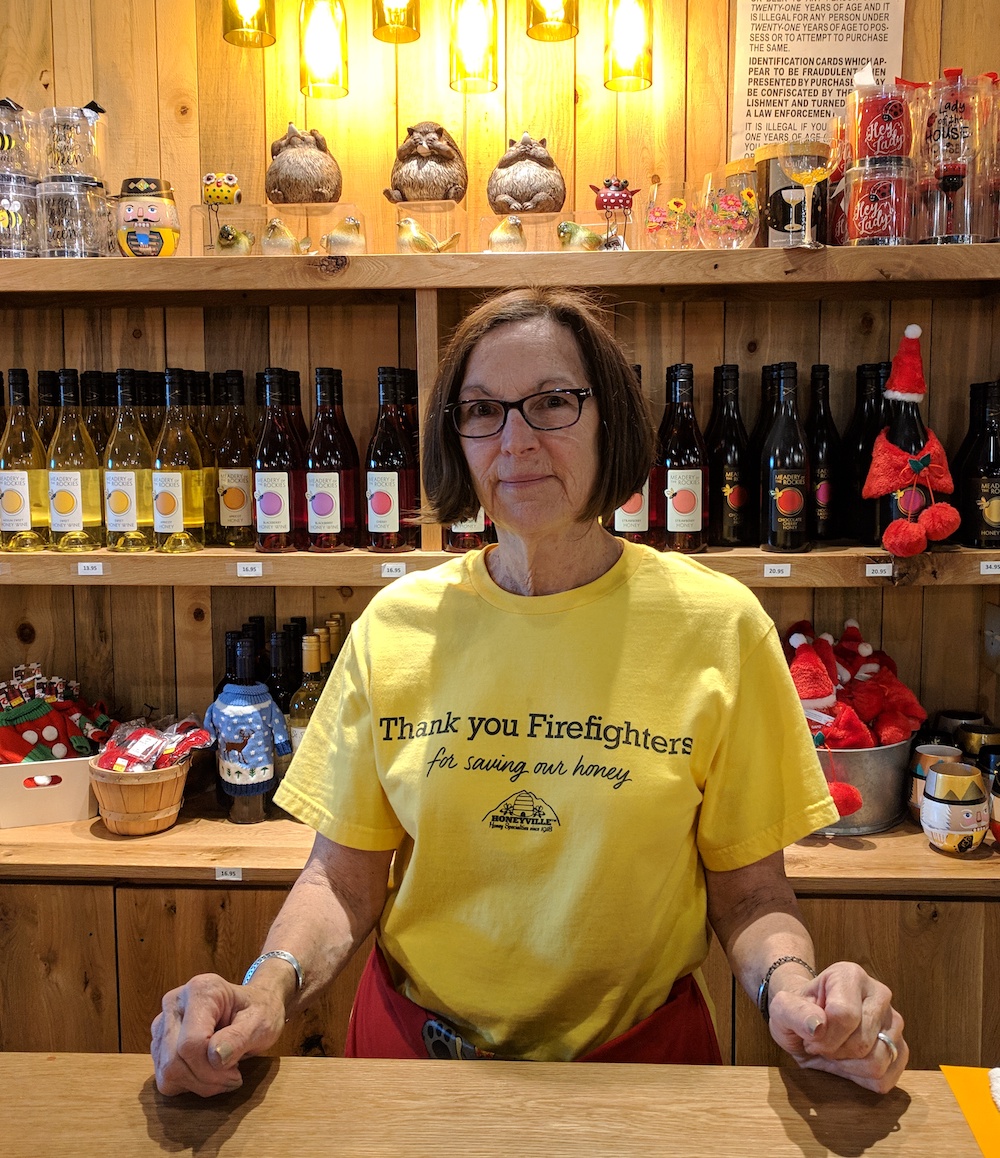
We also asked a series of questions to understand if respondents were aware of local wildfire mitigation programs, whether or not they participated, and the reasons why they chose not to participate. Approximately 40 percent of respondents were aware of these programs (n = 83) and nearly 16 percent participated in a mitigation program within the last year (n = 31). The most common response was participating in FireWise certification or being part of a FireWise community (61.3 percent). Of the respondents who did not participate in a mitigation program within the last year, about 60 percent provided an explanation as to why (n = 70). The most common reasons were that respondents: engaged in mitigation themselves (n = 25); didn’t believe they lived in an area that required mitigation (n = 19); were unaware of these programs (n = 14); monetary costs or time (n = 3); or they didn’t think their home or property would be threatened (n = 2).
Barriers to wildfire mitigation
To better understand what hinders wildfire mitigation, we asked respondents to indicate barriers they faced before the 416 Fire, and barriers they anticipate facing in the 2019 fire season (Table 5). Before the 416 Fire the most common barriers were a lack of time (38.6 percent), not enough help with the tasks (27.9 percent), and other financial obligations (26.9 percent). Following the 416 Fire respondents still perceived a lack of time (15.3 percent) and/or help with the tasks (13.3 percent) as the main barriers with the inclusion of potential health issues or illness (11.9 percent) as an additional barrier to mitigating risk (Table 3). This increase in potential health issues or illness could be due to the average age of respondents; over 75 percent are over the age of 49. These results can shed light on how to navigate assistance programs in the 2019 fire season based on specific resident needs and identified trends in barriers to wildfire mitigation.
Table 3. Percentage of Animas Valley residents reporting specific barriers to engaging in wildfire mitigation before and after the 416 Wildfire
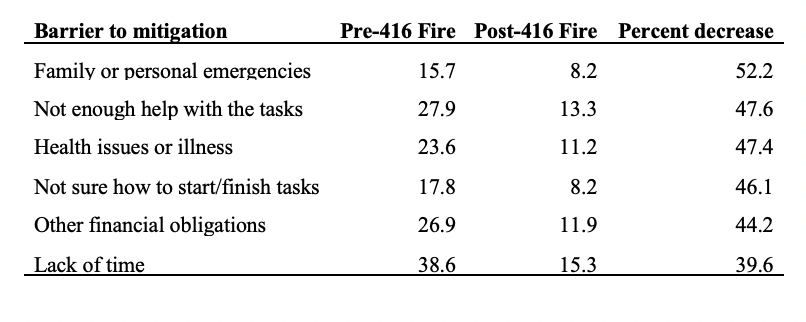
In addition, respondents were asked to describe any additional barriers they faced in mitigating risk before the 416 Fire and barriers they anticipate during the upcoming 2019 fire season. In total, 32 respondents mentioned additional barriers before the 416 Fire (n = 9) or perceived future barriers (n = 23) such as: neighbors brush creeping onto their property, homeowners’ associations, enjoying the natural look, their residence is a rental, not being able to financially afford mitigation, or being absent before the 416 ignition. After answering questions about perceived future barriers to wildfire mitigation, respondents were asked ‘Considering all of the costs associated with protecting your home and property from wildfire risk (labor, time, money), do you think the costs are worth the benefits?’ Nearly 90 percent said the costs are worth the benefits, approximately nine percent were unsure, and less than two percent said the costs are not worth the benefits.
Dimensions of Protection Motivation Theory
Perceived severity
To measure perceived severity before the 416 Fire, we asked ‘When you first heard about the 416 Fire did you think it would grow large enough to threaten residential areas?’ Most respondents (80 percent) thought it was somewhat or very likely, whereas 12 percent thought it was not very or somewhat unlikely, and eight percent were unsure.
Perceived vulnerability
To measure residents’ perceptions of vulnerability to wildfire before and after the 416 Fire we asked two questions: 1) ‘Before the 416 Fire, how likely did you think it was that a wildfire could start in Animas Valley?’, and 2) ‘How likely do you think it is that a wildfire could start in Animas Valley next year?’ Before the 416 Fire most respondents (88.3 percent) believed it was * somewhat * or * very likely* (Table 4) that a wildfire could happen in Animas Valley. However, after the 416 Fire only 68.9 percent believed a wildfire was * somewhat * or * very likely* to happen in Animas Valley in 2019 (Table 4).
Table 4. Pre- and post-fire perceptions of the likelihood a wildland fire could start in Animas Valley

Response efficacy
To understand how individuals’ perceptions of the effectiveness of mitigation actions changed after experiencing the 416 Fire we asked respondents to indicate how much they believed each mitigation action we asked about would reduce their risk of future wildfire damage. After experiencing the 416 Fire, most respondents agreed that three mitigation behaviors had a moderate or major reduction to their future wildfire risk (Table 5). These actions included moving firewood and other combustibles 30 feet from the structures on their property (77 percent); disposing of dead fuel accumulation on property (73.5 percent); and thinning and pruning trees and shrubs within 30 feet of their home (73.3 percent).
Table 5. Level of perceived response efficacy for each mitigation behavior after experiencing the 416 Fire.
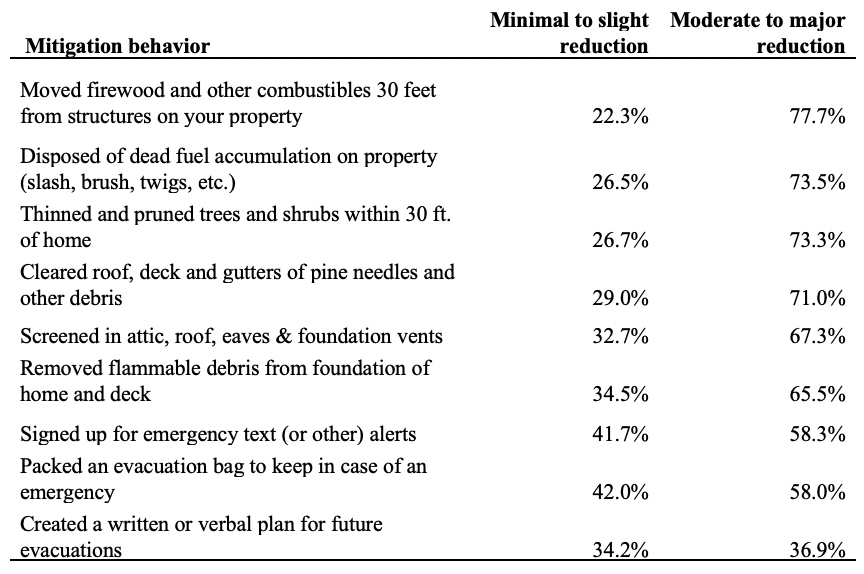
Self-efficacy
To measure self-efficacy, respondents were asked if they believed they could undertake all of the mitigation actions they intended to take before the 2019 fire season. Nearly 80 percent believed they could, approximately seven percent did not believe they could, and nine percent were unsure if they could undertake all of the mitigation actions planned for 2019. The remaining five percent did not have wildfire mitigation planned for 2019 or did not provide a response (1.5 percent).
Response costs
To measure response costs after experiencing the 416 Fire, one question asked respondents to indicate if they believed all of the costs associated with protecting their home and property from wildfire risk (e.g., labor, time, money) are worth the benefits. Most respondents (86.7 percent) stated that the costs were worth the benefits, less than two percent said they were not, and just under 10 percent were unsure.

Research Question 1: Which, if any, dimension of protection motivation theory was the best predictor of wildfire mitigation behaviors?
The pre-fire models used nine mitigation behaviors (Table 5) residents could have taken before the 416 Fire as dependent variables. The independent variables were perceived severity, perceived vulnerability, and response efficacy. Of the three independent variables, only response efficacy was a significant predictor of pre-416 Fire mitigation behaviors (Table 6). More specifically, response efficacy was significantly and positively related to: 1) creating a written or verbal plan for future evacuations; 2) packing an evacuation bag to keep in case of an emergency; 3) signing up for emergency text alerts; 4) screening in attics, roofs, eaves, and foundation vents; and 5) moving firewood and other combustibles 30 feet from structures (Table 6).
Table 6. Binary logistic regression results for pre-416 Fire mitigation actions and associated dimensions of protection motivation theory (predictors)
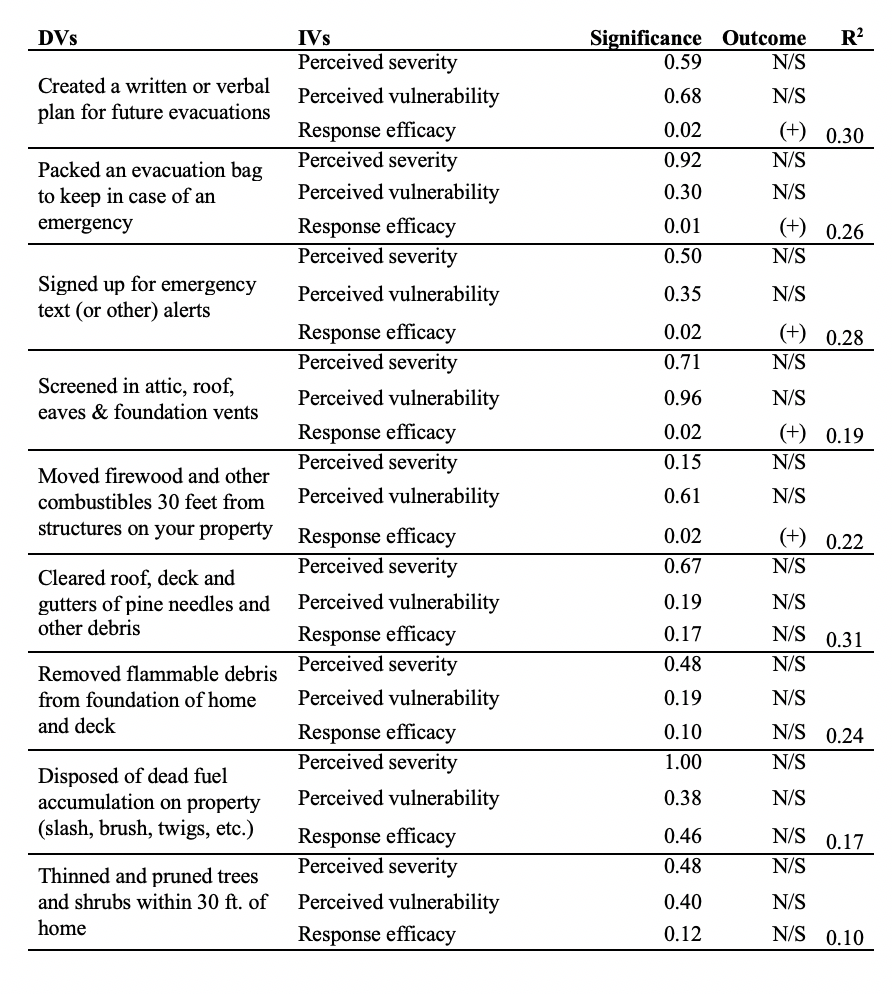
The post-fire models used the same nine mitigation behaviors (Table 6) that residents can implement to reduce their risk during future fire seasons. The independent variables for the post-416 Fire models were perceived vulnerability, self-efficacy, and response efficacy. Response efficacy and self-efficacy (i.e., belief in one’s capacity to carry out specified actions) were both significant predictors of four intended mitigation behaviors (Table 7). Response efficacy was a significant predictor of the intention to pack an evacuation bag to keep in case of an emergency and moving firewood and other combustibles 30 feet from structures on the property. Self-efficacy was a significant predictor of the intention to screen in attics, roofs, eaves, and foundation vents and thinning and pruning trees and shrubs within 30 feet of the home (Table 7).
Table 7. Binary logistic regression results for post-416 Fire mitigation actions and associated dimensions of protection motivation theory (predictors)
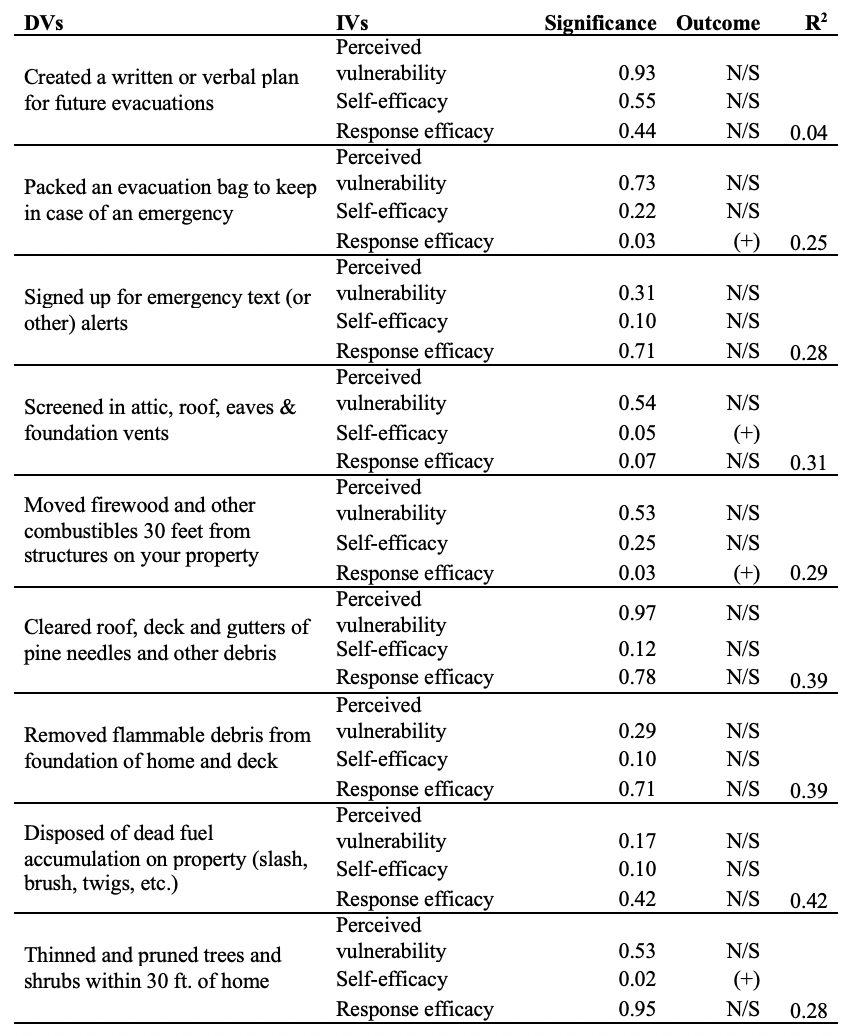
Research Question 2: Does a recent, proximal, wildfire influence residents’ perceptions or self-reported mitigation behaviors
To answer research question 2, we compared respondents’ perceptions of the likelihood of a wildfire occurring in the area pre- and post-fire. Before the 416 Fire most respondents (88.3 percent) believed it was somewhat or very likely, however, after the 416 Fire only 68.9 percent believed a wildfire was somewhat or very likely to happen in Animas Valley in 2019 (Table 4). These data reveal a 20 percent reduction in resident perceptions of the likeliness that a wildfire could happen in Animas Valley after experiencing a recent fire. These results lend support to previous studies that have shown dampened risk perceptions after experiencing a recent, proximal wildfire (Kasperson et al., 198816; McGee et al., 200917) or other natural hazard (Dillon et al., 201418; Dillon et al., 2011; Dillon et al., 2011). Interestingly, more respondents were unsure (17.9 percent) of how likely a wildfire could happen in Animas Valley after the 416 Fire, as compared to the number that were unsure before the fire (4.1 percent; Table 4). More respondents are uncertain of the likelihood of a wildfire in the upcoming year after experiencing a recent, proximal wildfire. Collectively, these results show that experiencing a near-miss wildfire event decreases the perceived likelihood of a wildfire event (perceived risk) within the next year, as well as an increase in uncertainty about this likelihood.
We also compared respondents’ implemented (pre-416 Fire) and intended (post-416) mitigation actions. Respondents were asked to indicate which (if any) mitigation actions they engaged in before and which (if any) they plan to engage in after experiencing the 416 Fire (Table 8). Before the 416 Fire, respondents mostly disposed of dead fuel accumulation on their property (60.9 percent); signed up for emergency text (or other) alerts (59.2 percent); or cleared the roof, deck, and gutters of pine needles and other flammable debris (58.4 percent). After the 416 Fire our respondents are still likely to sign up for emergency text or other alerts (84.0 percent) or dispose of dead fuel accumulation on their property (78.1 percent). However, residents were more likely to remove flammable debris from the foundation of their home and deck (75.0 percent) (Table 4). The most significant increases in planned mitigation behaviors are: signing up for emergency text or other alerts (24.8 percent increase); creating a written or verbal plan for future evacuations (21.1 percent); and packing an evacuation bag to keep in case of an emergency (19.5 percent). These results indicate that experiences with the 416 Fire pushed residents to engage in more personal preparedness measures in the case of an evacuation (e.g., create an evacuation plan, pack an emergency evacuation bag) as well as structural and vegetative mitigation (e.g., removing flammable debris, dispose of dead fuel accumulation).
Table 8. Mitigation behaviors enacted by Animas Valley residents prior to and after experiencing the 416 wildfire with the percentage of increase for each behavior. The top three pre- and post- 416 wildfire mitigation actions and the largest increases are highlighted in red
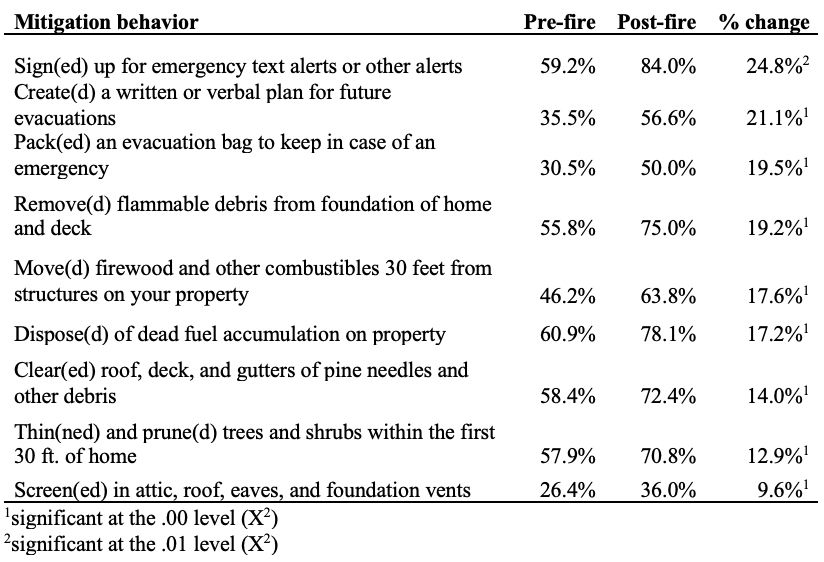
Discussion
Response efficacy of mitigation actions increased and barriers to mitigation decreased after experiencing the 416 Fire.
Results from this study show that individuals are perceiving structural and vegetative mitigation actions as being more effective at reducing their risk after experiencing a recent, proximal wildfire. To our knowledge the 416 Fire did not damage any homes or residential structures, which means individuals do not need to directly experience wildfire damage to view mitigation as effective in preventing damage. This could be related to what previous authors refer to as a ‘post-exposure wake-up call’. This happens when individuals are exposed to a hazard which leads to a greater awareness of the risk and a desire to take proactive measures to mitigate future exposure (Arvai et al., 200619). These results suggest that exposure to the 416 Fire brought awareness to residents of the types of wildfires they could experience in the future, as well as served as a ‘wake-up call’ to view mitigation actions as more efficient and potentially continue to engage in the on-going vegetative actions. The three mitigation behaviors that had the most substantial increases (moving firewood and other combustibles 30 ft. from structures; disposing of dead fuel accumulation; thin and prune trees and shrubs within 30 ft. of home) are vegetative actions suggested by the Colorado State Forest Service (C.S.F.S., 201920), and the National Wildfire Coordinating Group (2006)21. It is promising to see that more individuals are planning to engage in mitigation actions that are recognized by many institutions as contributing to risk reduction of structures and properties. An increased belief that these mitigation actions are effective at reducing wildfire risk may motivate individuals to continue engaging in these actions to keep their future level of risk low.
Before the 416 Fire, between 15 percent and 40 percent of respondents were experiencing mental, physical, or financial barriers to completing wildfire mitigation actions to their home or property. After the 416 Fire, only 8 to 13 percent of respondents perceive experiencing the aforementioned barriers in the upcoming fire season. This equates to a 40 percent to 52 percent reduction in perceived barriers after experiencing the 416 Fire. As mentioned above, experiencing the 416 Fire may have demonstrated the level of risk that exists for Animas Valley residents and in turn, made mitigation behaviors seem like a small task to reduce their overall risk. Further, residents may be viewing this as a near-miss that almost happened, which previous authors have identified as encouraging mitigation and preparedness (Tinsley et al., 201222). Future work should incorporate survey questions that determine whether residents view the near-miss event as one that was avoided (which leads to more risky behavior) or as an event that could have happened (which increases mitigation and preparedness). This information would help further predict the likelihood that individuals will engage in future wildfire mitigation to reduce their overall level of risk.
Significant differences and predictors of wildfire mitigation behavior
Overall, significant differences were found for all pre-416 and post-416 Fire mitigation behaviors. It appears that residents in Animas Valley have been motivated to take action after experiencing the nearby 416 Fire. This ties to the broader literature on how experience is defined and how it shapes risk perceptions and behavior. In this study, experience could be defined as: evacuation status; dealing with smoke, debris flows or flooding after the fire. Future studies should include these post-fire experiences into survey design to understand if there are specific aspects of a wildfire experience that are influencing intention to mitigate future wildfire risks.
Response efficacy (i.e., belief that the specific action will be effective in reducing risk) was a significant predictor of five pre-416 Fire and two post-416 Fire mitigation actions (seven total). However, it was not a significant predictor of: clearing the roof, deck, and gutters of pine needles and other debris; removing flammable debris from the foundation of the home or deck, disposing of dead fuel accumulation on the property, or thinning and pruning trees and shrubs within 30 ft. of the home (Table 6). This means that respondents view these actions as less effective or ineffective at reducing their risk to wildfire damage. Interestingly, all of these actions are included in the Defensible Space Checklist (C.S.F.S., 2019) as actions that lower risk to wildfire. Since response efficacy was a significant predictor of other mitigation actions on this checklist, future efforts should be made to emphasize the effectiveness of these actions. Research shows that it is more likely that a burning ember that lands on a home or property ahead of the flame front is more likely to result in ignition and destruction (Protecting your home from a wildland fire, 2016 23). Consequently, engaging in all of the nonsignificant mitigation actions (e.g., clearing flammable debris from the roof, deck, gutters, and foundation of home or deck; disposing of dead fuel accumulation; and thinning and pruning trees and shrubs within 30 ft. of the home) would directly result in lowered risk to wildfire. Future education and outreach should emphasize how effective these mitigation actions are at reducing structural and vegetative wildfire risk in the wildland urban interface.
Self-efficacy (i.e., belief in one’s ability to carry out specific actions) was a significant predictor of two post-416 Fire mitigation behaviors: screening in the attic, roof, eaves and foundation vents; and thinning and pruning shrubs within 30 feet of the home. However, it was not a significant predictor of the intention to: create a written or verbal plan for future evacuations; sign up for emergency alerts; clear the roof, deck, and gutters of pine needles and other debris; remove flammable debris from foundation of home and deck; or dispose of dead fuel accumulation on the property. Respondents don’t view themselves as capable of undertaking these actions, which could be due to a variety of factors. Two of these actions involve preparing for future wildfire evacuations. Respondents may not feel capable of completing these given the short period of time in which the survey was received (i.e., 3 months after the fire). The negative feelings or memories associated with the fire may have been fresh in their minds, causing them to not want to imagine another fire where they have to plan to evacuate. Self-efficacy was also not a significant predictor of three vegetative mitigation actions. In this case, our average respondent age may be contributing to the view that they are capable of clearing the roof, deck, and gutters of flammable debris, or removing flammable debris from the foundation. These actions may be too physically demanding or impossible for some respondents, which would explain the nonsignificant finding. Some respondents may create a list of mitigation actions they plan to complete each spring but run out of time when the fire season begins. This would make sense given ‘lack of time’ was the strongest barrier to mitigation both pre-416 and post-416 Fire. In addition, the action ‘dispose of dead fuel accumulation on property’ requires a truck or other large equipment, which two respondents pointed out in the open-ended text at the end of the survey. These respondents indicated that they were able to thin and prune the trees and brush but had no way of removing it since they do not own a truck. Incentive programs could be structured with these considerations in mind, and options should be provided to individuals with different barriers and different needs. For instance, those who are able to thin and prune vegetation could participate in a voluntary debris removal program. Those who are unable to physically participate in thinning and pruning could participate in a voluntary labor for mitigation program. These programs exist in La Plata county, however they may not be reaching individuals due to lack of awareness.
Conclusion
Collectively, this research offers new insights into why individuals take specific wildfire mitigation behaviors.
Our investigation also revealed that the 416 Fire served as ‘wake-up call’ for residents in the Animas Valley. For all of the mitigation behaviors we asked about, there was a significant increase in intentions to engage in those behaviors after the wildfire. These results suggest that experiences with the 416 Fire are pushing residents to engage in more personal preparedness measures in the case of an evacuation (e.g., create an evacuation plan, pack an emergency evacuation bag) as well as structural and vegetative mitigation (e.g., removing flammable debris, dispose of dead fuel accumulation). It is possible, however, that our survey respondents were more influenced by the 416 Fire relative to other residents living in the valley who either did not respond to the survey or were not sampled. Appropriate caution should be taken when reviewing the findings presented here.
Grounding our investigation in protection motivation theory, we were able to determine that response efficacy was as significant predictor of several planed mitigation actions. However, response efficacy was not a significant predictor of: clearing the roof, deck, and gutters of pine needles and other debris; removing flammable debris from the foundation of the home or deck, disposing of dead fuel accumulation on the property, or thinning and pruning trees and shrubs within 30 ft. of the home. This means that respondents view these actions as less effective or ineffective at reducing their risk to wildfire damage. Future efforts should be made to emphasize the effectiveness of these actions.
Local, regional, and state planners can take the findings from this study into consideration when designing and implementing outreach and education campaigns intended to increase the proactive mitigation behaviors amongst residents living in high-risk areas of the wildland urban interface.
References
-
Radeloff, V.C., Helmers, D.P., Kramer, H.A., Mockrin, M.H., Alexandre, P.M., Bar-Massada, A., Butsic, V., Hawbaker, T.J., Martinuzzi, S., Syphard, A.S., and Stewart, S.I. (2018). Rapid growth of the US wildland-urban interface raises wildfire risk. Proceedings of the National Academy of Sciences, 115(13), 3314-3319. ↩
-
Dupéy, L.N., & Smith, J.W. (2018). An integrative review of empirical research on perceptions and behaviors related to prescribed burning and wildfire in the United States. Environmental Management, 61, 1002-1018. ↩
-
McCaffrey, S.M., & Olsen, C.S. (2012). Research perspectives on the public and fire management: A synthesis of current social science on eight essential questions. JFSP Synthesis Reports, 17. http://digitalcommons.unl.edu/jfspsynthesis/17 ↩
-
McCaffrey, S.M., Toman, E., Stidham, M., & Schindler, B. (2013). Social science research related to wildfire management: An overview of recent findings and future research needs. International Journal of Wildland Fire, 22 (1). 15–24. https://doi.org/10.1071/WF11115 ↩
-
Toman, E., Stidham, M., McCaffrey, S., & Schindler, B. (2013). Social science at the wildland-urban interface: A compendium of research results to create fire-adapted communities. U.S. Department of Agriculture, Forest Service, Northern Research Station. Newtown Square, PA, 75. doi:10.2737/NRS-GTR-111 ↩
-
Russell, L.A., Goltz, J.A., & Borque, L.B. (1995). Preparedness and hazard mitigation actions before and after two earthquakes. Environment and Behavior, 27(6) 744-770. ↩
-
Dillon, R.L. & Tinsley, C.H. (2016). Near-miss events, risk messages, and decision making. Environment Systems and Decisions, 36(1) 34-44. ↩
-
Dillon, R.L., Tinsley, C.H., and Cronin, M. (2011). Why near-miss events can decrease an individual’s protective response to hurricanes. Risk Analysis, 31(3) 440-449. ↩
-
Bubeck, P., Botzen, W.J.W., and Aerts, J.C. (2012). A review of risk perceptions and other factors that influence flood mitigation behavior. Risk Analysis: An International Journal, 32(9), 1481-1495. ↩
-
InciWeb developed and maintained by USDA Forest Service, F. A. (n.d.). InciWeb the Incident Information System. Retrieved from https://inciweb.nwcg.gov/ ↩
-
Romeo, J. (2018, December 01). Six months later, no cause released for 416 Fire. Retrieved from https://durangoherald.com/articles/252763 ↩
-
Lovelock, C.H., Stiff, R., Cullwick, D., & Kaufman, I.M. (1976). An evaluation of the effectiveness of drop-off questionnaire delivery. Journal of Marketing Research, 13(4), 358-364. ↩
-
Melevin, P.T., Dillman, D.A., Baxter, R.K., & Lamiman, C.E. (1999). Personal delivery of mail questionnaires for household surveys: A test of four retrieval methods. Journal of AppliedSociology, 69-88. ↩
-
Dillman, D.A., Smyth, J.D., and Christian, L.M. (2008). Internet, Mail, and Mixed-Mode Surveys: The Tailored Design Method. 3rd ed. New York: Wiley. ↩
-
Hunter, L.M., Boardman, J.D., & Onge, J.M.S. (2005). The association between natural amenities, rural population growth, and long‐term residents' economic well‐being. Rural Sociology, 70(4), 452-469. ↩
-
Kasperson, R.E., Renn, O., Slovic, P., Brown, H.S., Emel, J., Goble, R., Kasperson, J.E., & Ratick, S. (1988). The social amplification of risk: a conceptual framework. Riskanalysis, 8(2), 177-187. ↩
-
McGee, T.K., McFarlane, B.L., & Varghese, J. (2009). An Examination of the influence ofhazard experience on wildfire risk perceptions and adoption of mitigation measures. Society & Natural Resources, 22(4), 308-323. doi:10.1080/08941920801910765 ↩
-
Dillon, R.L., Tinsley, C.H., & Burns, W.J. (2014). Near-misses and future disaster preparedness. Risk Analysis, 34(10), 1907-1922. doi:10.1111/risa.12209 ↩
-
Arvai, J., Gregory, R., Ohlson, D., Blackwell, B., and Gray, R. (2006). Letdowns, wake-up calls, and constructed preferences: people’s responses to fuel and wildfire risks. Journal of Forestry, 104(4), 173-181. ↩
-
C.S.F.S. Protect Your Home, Property & Forest from Wildfire. (2019). Colorado State Forest Service. Retrieved from https://csfs.colostate.edu/wildfire-mitigation/protect-your-home-property-forest-from-wildfire/ ↩
-
National Wildfire Coordinating Group Communicator's Guide for Wildland Fire Management: Fire Education, Prevention, and Mitigation Practices. (2006). https://www.nifc.gov/PUBLICATIONS/communicators_guide/9 Fire Mitigation.PDF ↩
-
Tinsley, C.H., Dillon, R.L., & Cronin, M.A. (2012). How near-miss events amplify or attenuate risky decision making. Management Science, 58(9), 1596-1613. ↩
-
Protecting your home from a wildland fire (Science Spotlight). (2016, July 12). Retrieved https://www.fs.fed.us/rmrs/science-spotlights/protecting-your-home-wildland-fire ↩
Smith, J. W., & Dupéy, L. N. (2019). Close But No Cigar: The Influence of a Near-Miss Wildfire on Risk Perception and Mitigation (Natural Hazards Center Quick Response Research Report Series, Report 291). Natural Hazards Center, University of Colorado Boulder. https://hazards.colorado.edu/quick-response-report/close-but-no-cigar